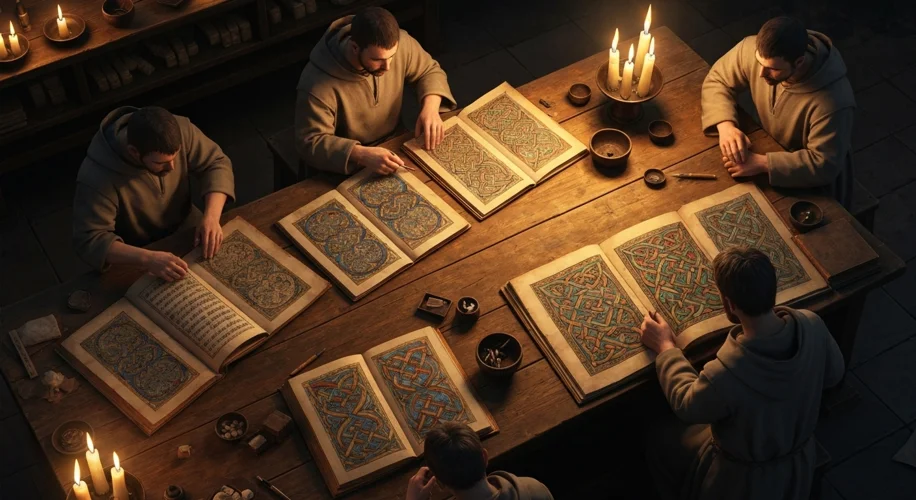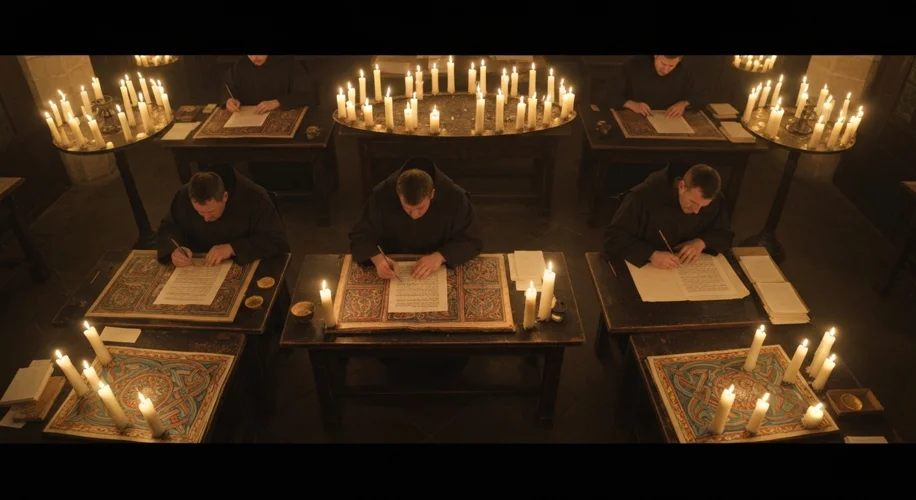In the hushed, candlelit scriptoria of early medieval Ireland, a miracle of art and devotion was unfolding. Imagine the scene: monks, their faces illuminated by flickering flames, meticulously bending over vellum, their quills dancing to create not just words, but vibrant, intricate worlds. This was the birthplace of the Book of Kells, a Gospel book of the New Testament so breathtakingly illuminated that it continues to captivate scholars and art lovers over a millennium later.

Created in the early 9th century, the Book of Kells is far more than just a religious text. It is a testament to the dedication, skill, and profound artistic vision of its anonymous creators. Its pages burst with an astonishing array of colors – deep blues derived from lapis lazuli, vibrant reds from ochre, and rich greens from plant-based pigments, all applied with a precision that defies its age. The interlacing patterns, zoomorphic figures, and elaborate initial letters are not mere decoration; they are a visual language, drawing the reader into the sacred stories with an immersive beauty.
But the allure of the Book of Kells extends beyond its undeniable aesthetic brilliance. For centuries, it has been believed to have originated from the monastic community of Iona, off the coast of Scotland, before being brought to Kells in County Meath, Ireland, for safekeeping, likely due to Viking raids. This narrative, however, is not as firmly established as one might assume. The very genesis of this masterpiece is shrouded in a fascinating historical ambiguity, a tantalizing puzzle that offers a deeper dive into early medieval Irish art, monastic life, and the very methods by which knowledge was preserved and transmitted.
The historical context of the 9th century was one of both fervent religious devotion and profound upheaval. The Viking Age was in full swing, with Norse raiders frequently disrupting the peaceful existence of monastic communities across the British Isles. These monasteries were not merely places of prayer; they were centers of learning, repositories of ancient texts, and vital hubs of artistic production. The scriptoria, like the one that likely produced the Book of Kells, were sanctuaries of intellectual and creative endeavor. The monks, often educated and skilled in various arts, dedicated their lives to copying and illuminating religious and classical texts, preserving a legacy that might otherwise have been lost to the ravages of time and conflict.
The key actors in this historical drama are, for the most part, the anonymous monks themselves. Their dedication, their mastery of materials and techniques, and their unwavering commitment to their craft are the driving forces behind the Book of Kells. Their perspective, filtered through their religious beliefs and the realities of their world, is embedded in every stroke of the quill and every daub of pigment. While we may never know their names, their spirit and intellect live on in the pages they so painstakingly created. The prevailing scholarly perspective, for a long time, pointed to Iona as the primary birthplace, a conclusion drawn from historical inferences and the stylistic similarities to other Insular art found in the region.
However, the ‘event’ itself – the creation of the Book of Kells – is not a singular moment but a process. The manuscript is famously unfinished, with some pages featuring little more than faint sketches, hinting at the ongoing nature of its creation and perhaps the disruption that ultimately halted its completion. This unfinished state, rather than detracting from its value, adds another layer of intrigue. It allows us to glimpse the working methods of the scribes and illuminators, to see the raw artistic process laid bare. The potential rewriting of its origins suggests that the Kells monastery itself might have been the primary site of its creation, or at least a significant contributor to its development, rather than merely a place of refuge.
The consequences and impact of the Book of Kells are immeasurable. It stands as one of the most significant artistic achievements of the early medieval period, a cornerstone of Insular art. Its influence can be seen in subsequent artistic traditions, and it continues to inspire artists, designers, and calligraphers today. Furthermore, its survival is a powerful symbol of the enduring human desire to create, to preserve knowledge, and to express spiritual devotion through art. The ongoing scholarly debate about its origins highlights the dynamic nature of historical interpretation. It reminds us that the past is not a fixed entity but a landscape that is continually being re-examined and re-understood as new evidence emerges or existing evidence is re-contextualized.
Analyzing and interpreting the Book of Kells involves delving into its intricate iconography, its linguistic peculiarities, and the broader context of early medieval Christianity and art. The sheer labor involved in its creation – the preparation of vellum, the grinding of pigments, the hours of painstaking work – speaks volumes about the value placed upon it by its creators. The debates about its origin, whether it was solely an Iona product or a collaborative effort involving Kells, underscore the challenges of reconstructing the past from often fragmentary evidence. This ongoing scholarly pursuit, driven by a deep curiosity about this extraordinary object, ensures that the Book of Kells remains not just a relic of the past, but a living, breathing subject of historical inquiry. It is a powerful reminder that even in the face of uncertainty, the pursuit of knowledge and the appreciation of human creativity can illuminate the darkest corners of history.

